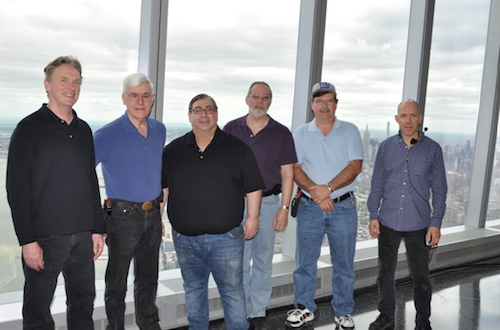It takes a certain sort of courage to return to a site of trauma. The attacks on Sept. 11, 2001, are etched onto the nation’s memory, but for those who lost someone that day, the pain can be even more acute. So on May 18, when members of New York Local 1212 stepped into the One World Trade Center, their four lost brothers who were working on 9/11 were with them.
It was the first time that anyone from New York’s broadcast local participated in a live broadcast in the new Trade Center since 9/11. The crew was there to help coordinate an exclusive broadcast of “CBS This Morning” from the 102nd floor, in the newly opened One World Observatory, a public space offering a breathtaking view of lower Manhattan, for the first time since the towers fell.
“It was a great privilege to be involved in a broadcast from there,” said Local 1212 member Art Starr, a member of the audio crew. “Knowing that some of our brothers had been there … it meant something special to me.”
 |
| New York Local 1212 members stand in the One World Observatory after the broadcast of CBS This Morning. From left to right, Dave Morris, Tom Jimenez, Joe Marcus, Art Starr, Bill Naeder, Mike Mullen.
|
The One World Trade Center, one of several buildings constructed on the site of the Twin Towers, officially opened in November after eight years of construction. CBS This Morning was invited to be the first live show to film in the building, and was able to introduce the One World Observatory, which opened its doors to the public on May 29, to its audience.
The crew had to arrive two days in advance of the broadcast to set up a remote control room, studio, and transmission facility, temporary structures that would coordinate the video and audio components to and from the CBS Broadcast Center in nearby Hell’s Kitchen, the normal site for the show. Fiber cables had to be laid to enable these communications, including seven lines for cameras and two for teleprompters and the return feeds that allow the anchors to interview people in different locations.
Even the staff of the observatory gained new perspective from the broadcast. In at 5 a.m. to prepare for the 7 a.m. broadcast, the observatory staff was mesmerized by the view. “We all watched the sun rise over the city,” Starr said. “It was beautiful.”
This new public space features several exhibits, including Voices, an exhibit on the men and women who helped build the One World Trade Center, and City Pulse, an installation that uses high-definition monitors and gesture-recognition technology to allow visitors to explore New York and its neighborhoods in depth. There is also a restaurant and a gift shop, and the elevators show a presentation on the construction of the New York skyline. The biggest draw, however, is the giant windows one the 101st floor that offer a 360-degree of the city, providing the greatest testament of the resilience of New Yorkers and their determination to overcome adversity.
Local 1212 boasts 1,800 members working in radio and television broadcasting, coordinating audio and visuals for New York networks, including WCBS, WNET, and HBO. The four members who were on transmitter duty, monitoring television broadcasts, in the Twin Towers on 9/11 were Gerard “Rod” Coppola (WNET), Stephen Jacobson (WPIX), Robert Pattinson (CBS), and Isaias Rivera (CBS).
For more information about the IBEW and the One World Trade Center, see the article “In Lower Manhattan, A Tower Rises on Holy Ground” from the May issue of “The Electrical Worker.” For information about visiting the One World Observatory, please visit https://oneworldobservatory.com/. To view the broadcast, visit http://newyork.cbslocal.com/2015/05/20/cbs-this-morning-one-world-trade-center/.
Photo used under a Creative Commons license for Flickr user Kai Brinker.